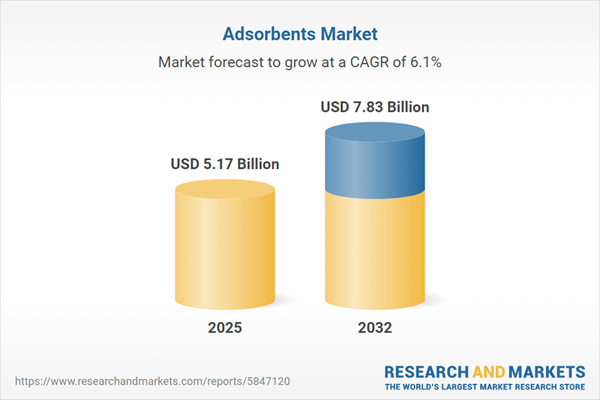Speak directly to the analyst to clarify any post sales queries you may have.
Senior stakeholders in the adsorbent market navigate an environment shaped by evolving procurement, sustainability, and regulatory demands. Reliable foresight and adaptive strategies are now critical for driving operational excellence and meeting competitive benchmarks in an increasingly dynamic sector.
Adsorbent Market Snapshot: Size, Growth Trends, and Primary Keyword
The global adsorbent market stands at USD 4.88 billion in 2024, with projections of USD 5.17 billion by 2025 and anticipated growth reaching USD 7.83 billion in 2032, representing a CAGR of 6.07%.
This sustained expansion is attributed to more stringent environmental oversight, accelerated uptake of sustainability initiatives, and increasing automation in manufacturing processes. Companies are proactively investing in advanced adsorbent materials to respond to compliance needs, optimize resource management, and deliver greater value to stakeholders. Leadership priorities increasingly focus on embedding innovative solutions, strengthening operational frameworks, and maintaining resilience as the market landscape evolves.Scope & Segmentation: Targeted Analysis of the Adsorbent Market
- Type: Activated carbon, molecular sieves, silica gel, and zeolites serve critical roles in purification, gas separation, moisture removal, and contaminant capture. Each material meets distinct industry performance needs, enhancing flexibility across manufacturing, chemicals, and environmental sectors.
- Application: Air purification, solvent recovery, process catalysis, and hydrogen or biogas streamlining are leading uses. Advanced water treatment and contamination remediation are vital in environmental protection, and precision chromatographic workflows target pharmaceutical and research requirements.
- End-User Industry: Automotive industries deploy adsorbents for improved emission control. Chemical and manufacturing segments secure process integrity, while food and beverage sectors prioritize product safety and consistency. Oil and gas industries drive operational efficiency, and the pharmaceutical and water sectors rely on adsorbents for regulatory compliance and exacting process standards.
- Region: North America prioritizes transparent procurement practices and operational efficiency. Asia-Pacific benefits from infrastructural growth and enhanced sourcing agility. EMEA exemplifies leadership in regulatory frameworks and advanced water management, supporting best practices and sector modernization.
- Key Companies: Industry progression is shaped by Evonik Industries AG, BASF SE, Wacker Chemie AG, Mitsubishi Chemical Corporation, Kuraray Co., Ltd., Cabot Corporation, Calgon Carbon Corporation, W. R. Grace & Co.-Conn, Honeywell International Inc., and LANXESS AG through technological innovation, strategic partnerships, and integrated R&D efforts.
Key Takeaways for Senior Decision-Makers
- Adoption of innovative adsorbent technologies enables businesses to achieve sustainability targets and integrate circular resource models into their core operations.
- Procurement approaches now emphasize flexibility and regional diversification, fostering supply chain resilience and reducing the impact of external disruptions.
- The integration of Industry 4.0 tools and advanced analytics enhances facility oversight, allowing for real-time asset management and predictive maintenance.
- Targeted investment in technology aligns operational capabilities with shifting regulatory expectations and strengthens compliance without sacrificing flexibility.
- Sustainability efforts drive the uptake of resource recovery and lifecycle initiatives, supporting environmental goals alongside operational profitability.
Tariff Impact: Navigating Shifting Trade Policies
New tariffs in the U.S. on carbonaceous and aluminosilicate inputs are prompting suppliers to diversify sourcing and expand recycled feedstock use. Adaptive procurement tactics, such as duty exemption applications and flexible supply strategies, help sustain reliable supply chains and competitive costs as the international trade landscape evolves.
Methodology & Data Sources: Ensuring Reliable Intelligence
This report draws on executive interviews, technical briefings, and primary B2B procurement research. Scenario analysis and scientific triangulation further validate insights, providing actionable, evidence-based intelligence for leadership teams and procurement specialists.
Why This Report Matters: Actionable Intelligence for Leadership
- Supports organizations in sustaining operational continuity and building robust supply chains amid regulatory shifts and changing market dynamics.
- Enables benchmarking and selection of appropriate technology solutions to enhance productivity and inform long-range strategic planning.
- Facilitates leadership alignment with compliance and environmental stewardship through clear, actionable insights.
Conclusion
This report empowers senior decision-makers to refine market strategies, strengthen operational responses, and uphold competitiveness within a rapidly changing industrial environment.
Additional Product Information:
- Purchase of this report includes 1 year online access with quarterly updates.
- This report can be updated on request. Please contact our Customer Experience team using the Ask a Question widget on our website.
Table of Contents
3. Executive Summary
4. Market Overview
7. Cumulative Impact of Artificial Intelligence 2025
Companies Mentioned
The companies profiled in this Adsorbents market report include:- Evonik Industries AG
- BASF SE
- Wacker Chemie AG
- Mitsubishi Chemical Corporation
- Kuraray Co., Ltd.
- Cabot Corporation
- Calgon Carbon Corporation
- W. R. Grace & Co.-Conn
- Honeywell International Inc.
- LANXESS AG
Table Information
| Report Attribute | Details |
|---|---|
| No. of Pages | 187 |
| Published | November 2025 |
| Forecast Period | 2025 - 2032 |
| Estimated Market Value ( USD | $ 5.17 Billion |
| Forecasted Market Value ( USD | $ 7.83 Billion |
| Compound Annual Growth Rate | 6.0% |
| Regions Covered | Global |
| No. of Companies Mentioned | 11 |









